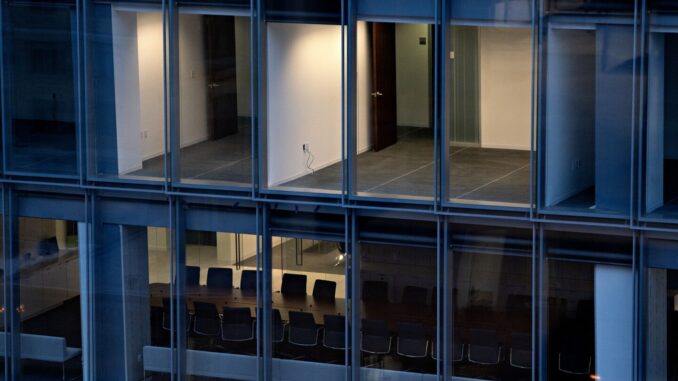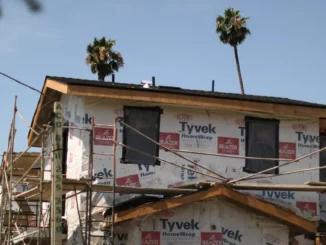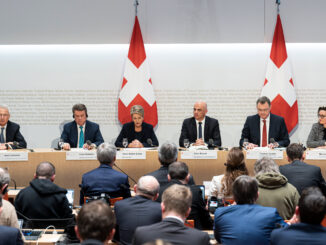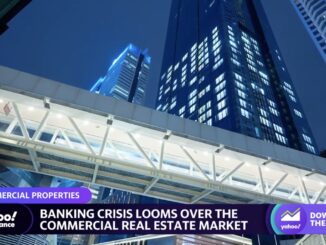
Another midsized bank, Raleigh, N.C.-based First Citizens, will purchase Silicon Valley Bank, the Federal Deposit Insurance Corporation announced early Monday morning. Over the past two decades, such regional banks — as SVB and Signature Bank had been — have grown enormously as commercial real estate boomed, because such banks rely heavily on lending to businesses and property developers.
But the pandemic upended office leasing and construction, with many companies shifting to remote work and reducing their office space. That has quashed demand, leaving the market saturated with vacancies and threatening to push property values down.
So far, developers and the banks that lend to them haven’t been badly affected, because commercial real estate leases tend to span several years, unlike the one-year terms for most residential units. But millions of these leases are going to expire over the next two years, potentially setting off a domino effect that could rattle the U.S. financial system.
The nightmare scenario would come if companies decide not to renew their leases or insist on much more favorable terms, driving the value of commercial real estate down across the board.
That would mean the loans many banks have made against office buildings are suddenly worth less than they are now, especially with interest rates much higher today than a year ago. And that, in turn, could make depositors and investors doubt banks’ financial stability — potentially leading to the same kind of runs that brought down SVB and Signature this month.
The banks at risk are not the Wall Street giants that defined the 2008 financial crisis, but the smaller regional institutions that have already suffered from wild swings this month. Before it collapsed and had to be taken over by the federal government earlier this month, Signature Bank had the 10th-largest portfolio of commercial real estate loans, according to the firm Trepp.
First Republic Bank, which Wall Street banks are trying to save from a potential collapse, has the ninth-largest, the firm found. Both were part of the class of midsize banks that could also be pummeled by a rapid deterioration in commercial real estate, analysts say. At the same time, these banks are also being squeezed by rising interest rates, which lower the value of their U.S. Treasury holdings and other long-term bonds bought at lower rates. (The value of existing bonds drop as interest rates rise, because buyers could get higher rates buying newer bonds.)
Although commercial real estate delinquencies ticked up by a 10th of a percentage point at the end of last quarter, they remain low by historic standards, S&P Global Market Intelligence found in a report this month.
But many institutions may still be quite vulnerable: At least 400 U.S. banks with at least $100 billion in total assets at the end of last year have three times as many loans for commercial real estate as they do safer investments, S&P found. Bigger banks also have substantial, if smaller, exposure. Some analyses have found that commercial real estate could contract in value by as much as 30 percent.
“It is a slow-moving train wreck,” said Brendan Walsh, a principal at Markets Policy Partners, which provides financial analysis to the public and to private firms. “You are really going to begin to see the stresses in the earnings of some of these banks, and how bad it will really get depends on how bad the commercial real estate market gets.”
Federal officials have maintained that the fears are overstated. Federal Reserve Chair Jerome H. Powell told reporters Wednesday that the banking system is on stable footing.
“We’re well aware of the concentrations people have in commercial real estate. Really don’t think it’s comparable to this,” Powell said at a news conference when asked whether commercial real estate posed a similar threat as SVB’s asset portfolio had. “The banking system is strong. It is sound. It is resilient. It’s well-capitalized. And I really don’t see that as at all analogous to this.”
Spokespeople for the Treasury, Federal Reserve and White House declined to comment. One Biden administration official, speaking on the condition of anonymity to describe internal talks, said policymakers have looked at potential risks in the financial sector, including commercial real estate, as part of regular practice predating the recent crisis.
There are reasons for optimism. More firms are ordering workers back into the office, and in several cities, occupancy rates have gone up, albeit remaining far below pre-pandemic levels.
Many midsize banks, seeing the potential danger last year, began diversifying their portfolios and stockpiling safe assets to protect against a downturn in commercial real estate. And while the danger may be real, analysts say the situation is nothing like the enormous housing bubble that precipitated the 2008 financial crisis — both because the amount of money involved is far smaller and because banks are far better positioned.
Still, analysts have waved red flags. KBW, a financial services firm, released a March 7 report that forecasts a more than 30 percent decline in the value of office property over the next two years. Jade Rahmani, a commercial real estate analyst at KBW, projected that prices would bottom out by the end of 2024, with the brunt of the losses realized this year and the next. The decline will happen in stages, as the pressure builds from mortgage defaults, loan modifications and forbearance by property owners and lenders.
It will take a while for values to fall, because loans won’t all come due at the same time. The commercial real estate market is only about 30 to 50 percent through its current decline, Rahmani estimated. That means the next two years will see even more office leases expiring.
Big losses in commercial real estate could have a cascading effect on the banks that already seem most at risk. Banks considered small or midsize — those with less than $250 billion in assets — account for roughly 80 percent of commercial real estate lending, according to Goldman Sachs economists Manuel Abecasis and David Mericle, meaning they are the most vulnerable to a downturn. Both Signature and SVB fell into this category, as do several others — including First Republic Bank and PacWest Bancorp — that have come under pressure since SVB’s collapse.
The downturn does not have to develop into a calamity to pose a real problem for the U.S. economy. A long slide in the commercial real estate market could mean job losses in construction, property management and other related industries. Abecasis and Mericle already project that small banks could reduce new lending by between 15 and 40 percent this year, which could drag down economic growth overall.
What would be even worse is if commercial real estate values plunge just as midsize banks come under unrelated pressure because of rising interest rates — leading to a multifaceted crisis with no obvious solution.
The implosion of SVB was triggered in part by the Federal Reserve’s campaign to raise interest rates to cool inflation, which led to a decline in the value of the bank’s long-term U.S. Treasury bonds. These rate hikes could still put banks under more stress, both because they make new lending more expensive and because they can throw existing bank assets out of balance.
A number of financial firms are unusually tied to commercial real estate. They includes two banks — Bank of Marin Bancorp and Community Financial Corp. — where office loans account for more than 20 percent of all lending, and more than a half-dozen banks with “notable” exposure, such as Citizens Financial Group, New York Community Bancorp and even the Wall Street giant Wells Fargo, according to the KBW report.
“Some banks will be quite exposed, and it’s really quite worrying,” said Eswar Prasad, a professor of economics at Cornell University. “If the safer parts of asset portfolios start falling in value as interest rates go up, and riskier parts of it like commercial real estate begin to go sour at the same time, that has very serious implications. This confluence is a major concern.”
How it all winds up may ultimately come down to just how many companies decide that they need to preserve their existing physical spaces.
Moody’s reported last week that revenue from office buildings is 10 percent less than what it should be based on national employment, and that companies are continuing to shed space they occupied before the pandemic. In Manhattan, office occupancy rose from about 30 percent of pre-covid levels for 2021 to close to 69 percent of pre-covid levels at the end of 2022. But in many cities — including San Francisco, Chicago and Austin — office occupancy remains below 50 percent of pre-2020 levels, based on an analysis of cellphone traffic conducted by Avison Young. Cushman & Wakefield, a commercial real estate brokerage firm, projected that per-employee office space will decline by about 10 percent permanently.
“This is a time of maximum uncertainty in lending,” said Stephen Miran, a former Treasury official in the Trump administration now at the firm Amberwave Partners. “The economy was looking very insensitive to interest rates, and everything has changed in the last two weeks.”
Source: www.washingtonpost.com



